Happy Saturday everyone.
Since I’ve been covering this diverter thing so closely, I figured I might as well keep holding the thread until the very end. That means I have an update on the story that I will share now instead of waiting for Monday morning.
First, for my latest thinking on the topic, don’t miss my previous story and/or the seven-minute explainer video I shared on Instagram Friday afternoon. Once you’ve done that, scroll down for the big update…
Friday night just after 8:30 pm I received an email from Deputy City Administrator of Public Works Priya Dhanapal (Public Works is the service area that includes the Portland Bureau of Transportation, so Dhanapal is essentially the boss of PBOT). Here’s the text of that email:
“There are no plans to remove the diverters this weekend. The City is coordinating logistics to determine the timing of removal and updates will be provided as they are available.”
My first reaction to this was a text to Connor Lennon, who had been occupying the diverter intersection at NW 20th and Everett since Thursday morning. I wanted to let Connor know he could go home and get some rest because there was no longer an imminent threat of diverter removal.
The City of Portland said the diverters would be removed last week. So for folks who don’t like that plan, this is a win. It shows how an informed community cannot be run over by people in power. But the fight to reach a better solution that addresses concerns the diverters have raised at the Portland Solutions office and Portland Police Bureau, is not over.
The email from Dhanapal validated a tip I received Thursday night about a pause. It makes sense to me and it’s the outcome I’ve predicted for a few days. Why? Because the political optics around this decision to remove the diverters has been bad from the start. To be clear, anyone associated with the removals as initially planned would suffer a very negative political consequence. That’s just my opinion, but it’s one formed by a tremendous amount of perspective and experience based on years of working on this issue in this community. From the moment I heard about this plan it did not smell right, and the evasiveness I’ve experienced from the City of Portland (Portland Solutions and Mayor’s office specifically) in trying to gain more clarity about it has only cemented my views.
A pause is what has always made the most sense — especially because there will be three meetings coming next week where city councilors, city administrators, and Mayor Wilson will have an opportunity to speak to each other publicly and on the record about this issue.
If I was betting on this, I’d say that on Monday we’ll receive some sort of written memo from DCA Dhanapal and/or the Mayor’s Office that lays out their argument for removing the diverters. Either that, or they’ll lay out a new plan in partnership with PBOT for a brief public outreach process to help better inform their goals and to steer the politics in a more positive direction. We’ll see what happens.
Thanks for following along with all this. I highly recommend doing some background reading if you’re not up to speed on this story. See all my posts about it here. Enjoy your weekend!
UPDATE 11:19 am: In related news, the Friends of Couch Park President Kara Colley has issued a letter to her organization saying she supports the diverters. This is notable because Portland Solutions, the Portland Police Bureau, and Mayor Wilson’s office have said that crime at Couch Park is a key part of their rationale for removing the diverters. Colley has been outspoken about crime and open drug use in the park, but she believes the diverters are a good thing for her neighborhood.
Below are excerpts from Colley’s “From the President’s Desk” note sent to members this morning:
“I think calmer, slower car traffic makes our neighborhood safer and more livable… I want to be clear that I support the Portland Police Bureau and the Central Precinct Bike Patrol… I know that there is frequent shoplifting and other crime right outside the Stadium Fred Meyer. I just don’t think that removing the diverters will reduce crime. All diverters must pass police/fire regulations before they are installed, and police can drive around the diverters when necessary.
I heard an interesting idea from a neighbor: The city could leave the diverters in place and remove one parking space and allocate that space to emergency vehicles only. I am in a “yes, and” moment here. I want the PPB to keep our neighborhood safe and I want the traffic diverters to slow down traffic on NW 20th.”

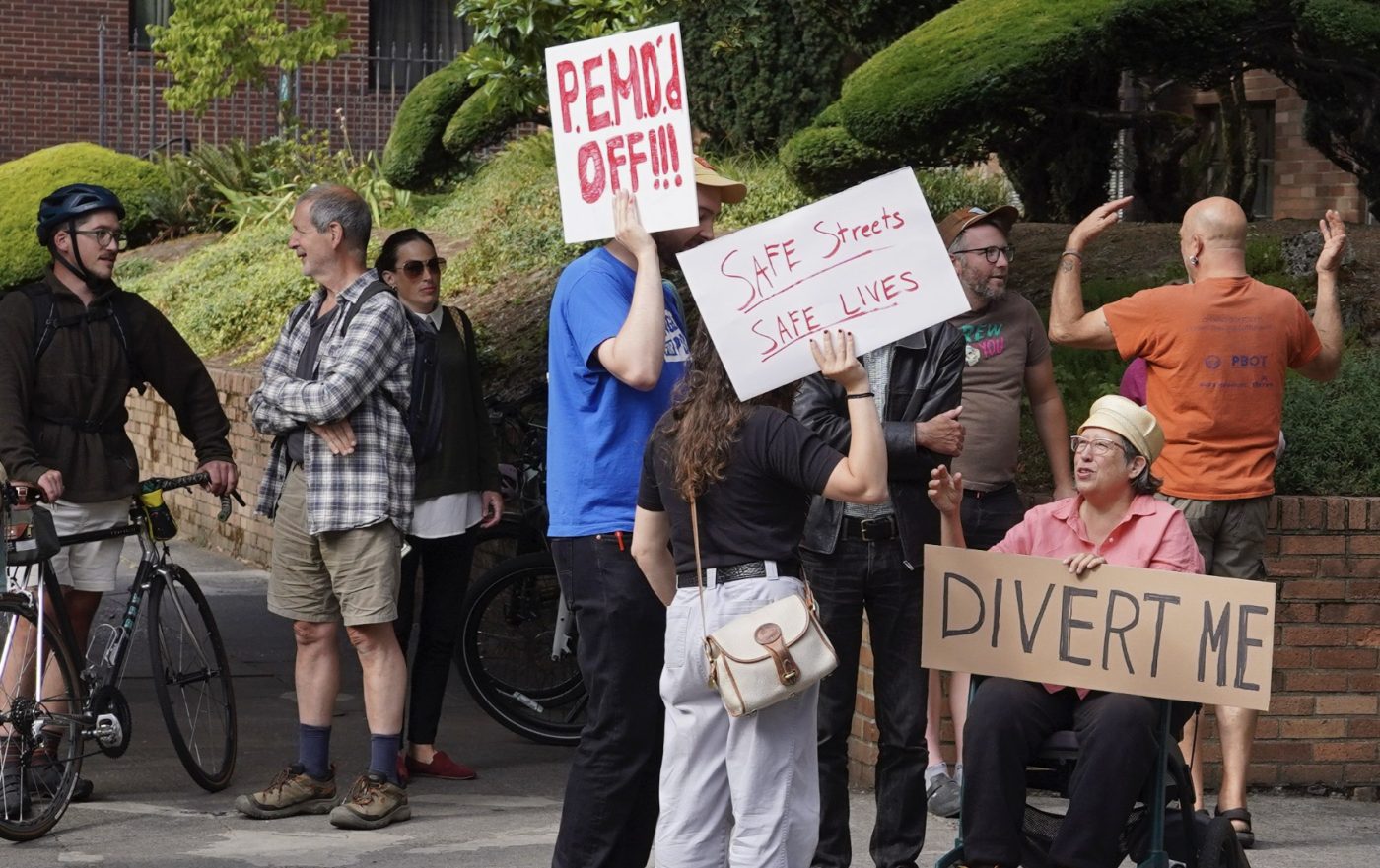
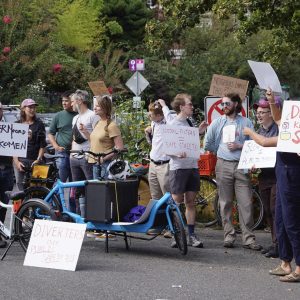
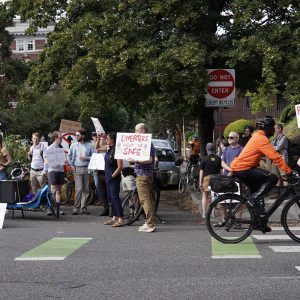
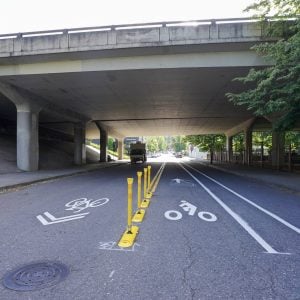
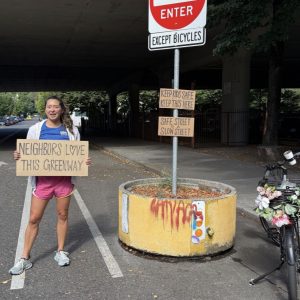
Thanks for reading.
BikePortland has served this community with independent community journalism since 2005. We rely on subscriptions from readers like you to survive. Your financial support is vital in keeping this valuable resource alive and well.
Please subscribe today to strengthen and expand our work.
Great reporting JM, and kudos for showing how an informed, local press can positively affect the world!!
I’ve been following every update in your coverage of this, thank you for all your hard work. This is exactly the kind of journalism that our city needs!
I thought Sarah Risser, from Families for Safe Streets, made an insightful comment in her words to the crowd on Thursday. I’m going from memory, and I’ll paraphrase, but she made the point that death is death, and that a death by car traffic should be taken with the same seriousness as a death from drugs or crime.
That really gets to the heart of the matter, and it’s subtle. Death or injury from a car is acceptable to many people in a way that death from crime or drugs is not. Death by auto is considered the price for getting around — it’s not a “real” safety issue, just “accidents.” That’s the attitude and misunderstanding of Vision Zero that needs to change.
The difference is the so-called criminal intent which is baked into the common law from hundreds of years ago and our collective psyche.
I think you must know this but if someone sells poison to a vulnerable person or points a gun and and pulls the trigger society views their behavior as worse as someone who pressed the wrong pedal of their car.
Perhaps you do not. I do. In that case good luck convincing others, you’ll be restricted in your converts to a few activists.
I find it interesting that the activist view as reflected in the Portland protest scene is that criminal justice is appropriate for the car driver when in general they look down or call for the abolition of the “carceral” criminal justice system.
What new solutions is being offered other than punishing drivers who kill? Years of narrowing lanes and installing weird paint and the traffic deaths have not gone down.
You are reading waaaay too much into what I wrote. There are a lot of ways to not feel safe. The possibility of getting hit by a car has always been my biggest safety concern (including when I lived in iffy east coast neighborhoods in the 80s).
We have to live with cars – we were forced into the situation.
Did you know that traffic lights create concentrated ‘groups’ of cars that are much more dangerous than the intermittent traffic that roundabouts create? This is the direction of innovative thinking that will reduce traffic collisions. Not like the way ‘Vision Zero’ goes about it.
Vision Zero design would probably favor roundabouts given how they slow vehicle speed and are (generally) better than huge, multi-lane signalized intersections. They are also wildly expensive. Powell & Cesar Chavez would be 1 billion percent better for everyone if it were a roundabout, but doing so would take ripping up and rebuilding the entire intersection. PBOT is straight broke.
I think the traffic volume at that intersection is too high for a roundabout. Have you ever experienced the roundabout further north on Cesar Chavez? At peak hours, cars back up for three or four blocks.
It is a poorly designed roundabout. But I’d expect a similarly bad design if pbot was going to do it again. That’s just how they roll.
Yes, roundabouts only work in specific scenarios and I think they’re overused already.
I missed the part where somebody said ‘I’d like a Poorly Designed Roundabout over there’. Roundabouts actually achieve higher throughputs than stoplight controlled intersections. The intermittent ‘failure’ of the Coe Circle design may well be due to its half measures of design but I suspect it also has somewhat to do with the way car traffic is metered into the intersection by nearby traffic control devices.
People balk at traffic circles because they just have not negotiated them before. Is that a reason to never adopt a better design that has been shown to work in real towns (with Republican mayors!)? It’s kind of like saying that we should not make left handed scissors because the left handed people among us are so used to wrangling with maladaptive tools that they wouldn’t care to have a thing that actually worked for them.
A roundabout at Powell & Cesar Chavez (two major boulevards!) would be insane, and roundabouts also demand more skills and alertness from drivers to avoid hitting other cars. The elderly tend to get confused and freeze up, and the young take too many risks with speed-bursts to avoid drivers entering & exiting the loop.
I’ve always seen roundabouts as a mixed safety bag, more of a trendy concept than something pragmatically thought through. Drivers often just aren’t competent enough to keep them safe. It’s too much like auto-racing, requiring multiple timing and weaving maneuvers, whereas stoplights create predictable patterns in straight lines. You just have to watch for speeders skewing the predictable part.
yes they should be well-designed but at a certain point we have to stop appeasing and accommodating for bad drivers. if you can’t handle a roundabout, you should not be operating a multi-thousand pound vehicle.
That gets into the impossible task of pre-banning drivers before they cause mayhem. You can’t do that in free countries, so it’s up to cyclists to not be trusting.
My main point was that you can’t safely put roundabouts on busy U.S. boulevards, no matter how “well-designed” they are. Cars jam up in queues due to volume, and other-driver-intent gets harder to predict. America is not a cooperative nation when it comes to driving.
You know activists arent a monolith, right?
And your comment really shows how normalized and accepted death by car is.
To stay alive, one must stay as alert as possible for bad drivers, debris in the road, etc. There’s too much emphasize on drivers holding all the responsibility for hitting cyclists when it’s a two-way street, so to speak.
I see far too much casual riding where cyclists assume cars will go exactly where predicted, or recklessly ride with no lights, etc. Any time you’re around cars it’s literally a life or death situation, with drivers not “owing” you the right to be seen and avoided 24/7. Motorcyclists are in the same situation.
you are confusing ‘taking safety into your own hands as a cyclist’ with ‘normalizing car violence’. Yes I think bikers should be alert & responsible, but ultimately if a biker gets hit it’s not a 50/50 responsibility split. As the operator of a vehicle that can kill or maim very easily, a driver has a much heavier weight of responsibility to drive carefully and alertly. Bikers are much less likely to harm others, and so have a smaller burden.
Also, the contention that bikers should pay attention doesn’t have to be in conflict with the contention that we should better our streets to make cars feel less like they can do whatever they want (and thus make other road users safer).
I can’t argue with you in theory, but the reality is that drivers are hard to trust, and if you’re badly maimed you won’t change their behavior in hindsight. It’s your life and no amount of indignance toward the state of the world will save it.
Portland’s 2020 lawless “Justice” movement exacerbated all of this by giving scofflaws an entitlement mentality. I recall far more politeness 10+ years ago. Actually, too polite, e.g. stopping in non-crosswalks to let stragglers cross while disrupting traffic flow and risking rear-end crashes.
I’m utterly familiar with the conditions you describe. It’s been my daily life for years and years. I’m going to paraphrase your comment as “Welcome to The Suck!”
The acceptance that you describe is why, no matter how often we tap the dial or check the weather, we’re sagging down from six percent. You can’t exactly send your friend or parent or child across town on a bike when you hand it over with a list of seven specific sketchy things they will encounter and a general injunction to not trust anybody in a car regardless of their notions about right of way.
If you have a party, do you put out a buffet with several flavors of choice dog food?
I didn’t think so.
All irrelevant to what Lisa wrote and what Sarah (according to Lisa) said.
Like Lisa said Sarah said, “Death is death”. How people are punished or not for causing a death is a separate issue.
You are missing the point. Entirely. My comment is about the value we place on human lives. If that life is taken in traffic it is treated, most of the time (with a few exceptions for DUIs and hit and runs), as not worthy of the justice system and I think it’s fair to say that road fatalities are not considered enough of a problem to trigger any real societal intervention. And this situation illustrates that perfectly. The Mayor can’t recognize the importance of increasing road safety. That is not something he cares about – clearly. I can’t speak for everyone at the rally but I am more supportive of the city – the state – honoring infrastructure changes that are intended to increase safety than punishing at-fault drivers. Some drivers who kill do so intentionally, but most of them don’t set out to kill another human. The system is so dangerous that people using it kill other road users every single day.
The idea that “narrowing lanes and installing weird paint and the traffic deaths have not gone down” is just anti-science and more than a bit dumb. We have studies proving the opposite. Bicyle infrastructure makes ALL OF US safer. https://narrowlanes.americanhealth.jhu.edu/
Well put. Perceived intent is often accidental with cars, though chronically bad drivers tend to be criminals in other areas.
The responsibility of cyclists and pedestrians to be fully aware of their surroundings and never assume a driver can see them is underemphasized in policy. They are not mere victims when they expect or demand predictable driving in a world where recklessness abounds. Always treating cars like a herd of stampeding bison is the best survival strategy.
Why should something as simple and commonplace as daily personal transportation involve serious injury or death? Especially death to uninvolved third parties who are not taking risks or seeking excitement but innocently doing mundane stuff? It’s a societal failure to let things like that happen.
We should use our resources of design to remove situations where people, any people, are vulnerable. We should thoroughly train all vehicle operators to manage time, space, and the physics of moving vehicles to avoid crashes. People who ignore these constraints should lose motor vehicle operation privileges.
Ignorance or other personal laxity should never be considered to excuse an operator failure in a heavy vehicle. Gun owners generally will not abide or associate with a person who does not use trigger discipline. We should have a similar standard for motor vehicle operation.
Human nature just isn’t all that great. As I wrote before, it’s all on YOU if your goal is staying alive and injury-free vs. maintaining a level of disdain for drivers (feels good but doesn’t save you).
I live in the neighborhood, unlike the “protesters” trucked in by BikeLoud.
This whole thing is a political stunt.
Trying to save lives is a political stunt?! Thanks for letting us know you are a trumper. Wouldn’t you be happier living in Florida pal? Bye bye
Some Portlanders just love a protest, it gives them purpose.
Nobody I’ve known over the years who has protested lacked purpose outside their protesting, to my knowledge.
But if some people are protesting against removing the diverters because it gives them purpose, I appreciate their efforts, since I agree the diverters should stay.
And some people actually feel strongly about things. That’s why they protest. Think about it..
That’s good, as long as they’re protesting for things that HELP public safety, unlike the 2020 war on cops that set off a crime wave and made existing bad drivers bolder.
That whole summer was an utter waste of time, effort and cost to clean up persistent hassles. It also directly led to a reduction in cycling via dangerous streets on many levels. I quit riding anywhere around downtown that year, plus the beloved Springwater Corridor, which I haven’t checked in many months. It still feels like some freak will run out of the bushes and stab or shoot cyclists.
You might live in that neighborhood, but I bike through it likely 10 times a week for my job. Why is my saftey not important there simply because I dont live in that neighborhood?
They checked my papers when I crashed into Nob Hill zone of good old Portland, but I did get there under my own power, no truck necessary
There was a post about the diverters in the PortlandOR subreddit a couple of days ago. The original post had a sentiment similar to yours. But several different people that claimed to be residents that lived within a block or two of the diverter voiced support for not removing it.
Keep in mind, the PortlandOR sub is the less moderated, more right wing local sub. So if people are commenting pro diverter and liking pro diverter comments in large numbers there, that suggests broad based support.
All that is to say, you don’t speak for your neighborhood, and many of your neighbors are strongly supportive of the diverters, including people that identify as car drivers.
I live in the neighborhood and I was there to protect the diverter as were many of my neighbors.
I live right across the street from Couch Park. It has serious nuisance issues and I often do not feel safe using the park. However removing this diverter would do nothing to remediate any issues in the neighborhood. We will be in the exact same situation just with more cars on 20th.
But f you get your way and the diverters are removed, won’t it be easier to truck in protesters for other things you don’t like in the future?
Did BikeLoud truck me in from NW 22nd and Kearney?
The BikeLoud truck? Huh?
Must have seen TruckLoud and got confused.
Has it occurred to you that people ride bikes over long distances? They don’t just use that small area to ride 1/4 mile and back. Anything along a route matters.
Portland’s protests used to be mostly meaningful until quasi-Justice culture took over in 2020 and disrespected even basic laws. The purpose of diverters is to limit the impact of bad behavior, but a certain type of protestor is actively bad. We have to be a more wholesome city, not catering to the fringe while it crushes decency.
I’m not familiar with this exact area, but the diverter debate feels driven more by ideology on both sides than by what actually works.
Speeding on streets is dangerous, and diverters can help address that. But they can also trigger counterproductive behavior from drivers and even cyclists making them unsuitable in many places.
Cars diverted from one street simply end up on another — and people live, work, and travel everywhere. For residents of streets effectively turned into private communities, that’s great. For those who get all the displaced traffic, not so much.
This creates a cycling landscape of haves and have-nots: a few enjoy overbuilt, sheltered corridors while others are left to navigate more hostile routes. It also creates an expectation among both drivers and cyclists alike that bikes don’t belong in the vast majority of shared spaces.
The result is a system that discourages cycling, reflected in pathetic numbers and longer term trends. Just ride along what should be busy cycle paths like Naito or Broadway during rush hour and you’ll see for yourself.
The ‘sheltered corridors’ benefit people that don’t live precisely on them, because people can and do travel on streets on which they don’t live. We are all ‘haves’ when we have nice bike routes, and I’m sure many people would take increased traffic on their street if one street over is made good for biking by reduced traffic.
People advocating for more traffic on their own street is not a thing — but willingness to increase traffic on someone else’s street definitely is.
The vast majority of miles anyone rides will be on streets they don’t live on
But that hardly translates to a vaguely equal benefit.
There’s a reason the same few sections of thousands of miles of streets in Portland get disproportionate attention year after year.
Yes, because it’s easier to control traffic on a few streets than on many. NW 21st Avenue is a neighborhood collector street and is literally the next street over from this one. That’s where cars are meant to go.
I think you have this backwards. My (poorly informed) guess is that the biggest complaint with diverters/bike lanes/traffic calming is from businesses and/or local residents that want it to be easier to drive autos conveniently to and from their business or residence. They would likely not frame their goal as ‘more traffic’ (they would call it ‘more convenience’ or ‘more efficiency’), but it’s more traffic.
Cars diverted from neighborhood streets mostly wind up on arterials because it’s no longer a time savings to cut through. Induced Demand, the phenomenon of car traffic expanding to fill whatever space it was given, is undefeated, and it applies in both directions (more lanes = more cars, fewer lanes = fewer cars) on all modes of traffic. Removing the car-removers from the bike route will reduce people’s willingness to bike and increase car traffic. Adding car-removers increases bike traffic, because most people don’t particularly care how, they just want to get somewhere.
Why do you think those particular cycle paths are largely empty? If someone who lives in SE/NE does not feel safe cycling with cars, how will they get to Naito or Broadway? Cities that have proven successful in increasing numbers have developed a network largely separated from interactions with cars.
What happens when driving is less convenient than other modes? In other cities where a separated network is prominent and transit is a viable option, people have a choice for how to travel. That means the number of cars on any one street isn’t fixed, but dependent on variables such as how practical and safe the bike network is (e.g., how many divertors are on a given street).
The former is not strictly true, and the latter is true only in the least interesting way.
Car travel patterns are influenced by the road network itself, and a less connected car network means less car travel on the network in general. The specific effects of any one treatment are not necessarily good. Certain key routes probably can’t reasonably be closed due to diversion, but I don’t think that NW 20th would be one of those routes, especially since it dead ends at Couch Park anyways. I think the most likely result of the barrier on the road network is very mildly reduced traffic overall, as people divert car trips from Fred Meyer to other destinations or modes (since it is less convenient to drive to as a result).
I think it’s worth having an honest dialogue about that trade off, and I strongly favor the treatment in large part because I think the loss of business to Fred Meyer/Kroger is insignificant, as it would likely consist only of cars driving in from NW/the Pearl via Everett/Glisan. Additionally, the detour is exceedingly minimal no matter what your route choice is, and since Burnside is going to carry the bulk of traffic for all trips to the Freddies anyways, I really don’t see how it could be anything other than a minuscule impact. How many people were driving to this Fred Meyer, were using exclusively Everett/Glisan, and feel that a detour to Burnside via 18th/19th is to onerous so as to have changed their grocery shopping patterns?
And yes, people live, work, and travel everywhere, but some roads, blocks, and offices are used more intensely than others. For places with a high intensity of uses, it’s difficult or impossible to accommodate drivers while also creating a safe environment for pedestrians and cyclists. The specific methodology of creating this safe environment is up for debate, but what’s not up for debate is the root cause of the problem: too many cars. I tend to be sympathetic towards a distributed network approach – but that is a bit of a hot take, and one that is not strictly practical.
This not really accurate, since everyone who rides a bike presumably enjoys the benefits of a good bike route. Sure, someone living on 34th/Clinton enjoys the lovely Clinton greenway more frequently than I do, but I still ride it a lot.
And I’ve recently started work in Seattle, and let me tell you the protected bikeway network in their downtown is always busy with riders. Maybe its because they actually have a network that serves many destinations, rather than two protected routes, one of which is one way only.